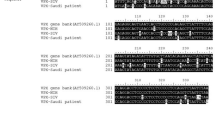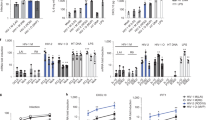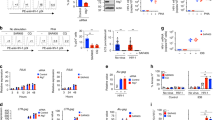Abstract
In the subset of primate lentiviruses that contain a vpu gene — HIV-1 and its simian precursors — the Nef protein has lost the ability to down-modulate CD3, block T cell activation and suppress programmed death. Vpu counteracts a host restriction factor induced by the inflammatory cytokine interferon-α. I propose that the acquisition of vpu may have allowed the viral lineage that gave rise to HIV-1 to evolve towards greater pathogenicity by removing the selective pressure for a protective Nef function that prevents damagingly high levels of immune activation.
This is a preview of subscription content, access via your institution
Access options
Subscribe to this journal
Receive 12 print issues and online access
$209.00 per year
only $17.42 per issue
Buy this article
- Purchase on Springer Link
- Instant access to full article PDF
Prices may be subject to local taxes which are calculated during checkout




Similar content being viewed by others
References
Silvestri, G., Paiardini, M., Pandrea, I., Lederman, M. M. & Sodora, D. L. Understanding the benign nature of SIV infection in natural hosts. J. Clin. Invest. 117, 3148–3154 (2007).
Pandrea, I., Sodora, D. L., Silvestri, G. & Apetrei, C. Into the wild: simian immunodeficiency virus (SIV) infection in natural hosts. Trends Immunol. 29, 419–428 (2008).
Liu, Z. et al. Elevated CD38 antigen expression on CD8+ T cells is a stronger marker for the risk of chronic HIV disease progression to AIDS and death in the Multicenter AIDS Cohort Study than CD4+ cell count, soluble immune activation markers, or combinations of HLA-DR and CD38 expression. J. Acquir. Immune Defic. Syndr. Hum. Retrovirol. 16, 83–92 (1997).
Giorgi, J. V. et al. Shorter survival in advanced human immunodeficiency virus type 1 infection is more closely associated with T lymphocyte activation than with plasma virus burden or virus chemokine coreceptor usage. J. Infect. Dis. 179, 859–870 (1999).
Sousa, A. E., Carneiro, J., Meier-Schellersheim, M., Grossman, Z. & Victorino, R. M. CD4 T cell depletion is linked directly to immune activation in the pathogenesis of HIV-1 and HIV-2 but only indirectly to the viral load. J. Immunol. 169, 3400–3406 (2002).
Silvestri, G. Naturally SIV-infected sooty mangabeys: are we closer to understanding why they do not develop AIDS? J. Med. Primatol. 34, 243–252 (2005).
Swanson, C. M. & Malim, M. H. SnapShot: HIV-1 proteins. Cell 133, 742 (2008).
Leitner, T. et al. (eds) HIV Sequence Compendium 2003 http://www.hiv.lanl.gov/content/sequence/HIV/COMPENDIUM/2003/0.pdf[online], (2003).
Neil, S. J., Zang, T. & Bieniasz, P. D. Tetherin inhibits retrovirus release and is antagonized by HIV-1 Vpu. Nature 451, 425–430 (2008).
Van Damme, N. et al. The interferon-induced protein BST-2 restricts HIV-1 release and is downregulated from the cell surface by the viral Vpu protein. Cell Host Microbe 3, 245–252 (2008).
Neil, S. J., Sandrin, V., Sundquist, W. I. & Bieniasz, P. D. An interferon-α-induced tethering mechanism inhibits HIV-1 and Ebola virus particle release but is counteracted by the HIV-1 Vpu protein. Cell Host Microbe 2, 193–203 (2007).
Schindler, M. et al. Nef-mediated suppression of T cell activation was lost in a lentiviral lineage that gave rise to HIV-1. Cell 125, 1055–1067 (2006).
Deacon, N. J. et al. Genomic structure of an attenuated quasi species of HIV-1 from a blood transfusion donor and recipients. Science 270, 988–991 (1995).
Kirchhoff, F., Greenough, T. C., Brettler, D. B., Sullivan, J. L. & Desrosiers, R. C. Absence of intact nef sequences in a long-term, nonprogressing survivor of HIV-1 infection. N. Engl. J. Med. 332, 228–232 (1995).
Arendt, C. W. & Littman, D. R. HIV: master of the host cell. Genome Biol. 2, REVIEWS1030 (2001).
Kirchhoff, F., Schindler, M., Specht, A., Arhel, N. & Münch, J. Role of Nef in primate lentiviral immunopathogenesis. Cell. Mol. Life Sci. 65, 2621–2636 (2008).
Ariën, K. K. & Verhasselt, B. HIV Nef: role in pathogenesis and viral fitness. Curr. HIV Res. 6, 200–208 (2008).
Fackler, O. T., Alcover, A. & Schwartz, O. Modulation of the immunological synapse: a key to HIV-1 pathogenesis? Nature Rev. Immunol. 7, 310–317 (2007).
Thoulouze, M. I. et al. Human immunodeficiency virus type-1 infection impairs the formation of the immunological synapse. Immunity 24, 547–561 (2006).
Djordjevic, J. T., Schibeci, S. D., Stewart, G. J. & Williamson P. HIV type 1 Nef increases the association of T cell receptor (TCR)-signaling molecules with T cell rafts and promotes activation-induced raft fusion. AIDS Res. Hum. Retroviruses 20, 547–555 (2004).
Fenard, D. et al. Nef is physically recruited into the immunological synapse and potentiates T cell activation early after TCR engagement. J. Immunol. 175, 6050–6057 (2005).
Fortin, J. F., Barat, C., Beausejour, Y., Barbeau, B. & Tremblay, M. J. Hyper-responsiveness to stimulation of HIV-infected CD4+ T cells requires Nef and Tat virus gene products and results from higher NFAT, NF-κB, and AP-1 induction. J. Biol. Chem. 279, 39520–39531 (2004).
Krautkramer, E., Giese, S. I., Gasteier, J. E., Muranyi, W. & Fackler, O. T. Human immunodeficiency virus type 1 Nef activates p21-activated kinase via recruitment into lipid rafts. J. Virol. 78, 4085–4097 (2004).
Manninen, A., Renkema, G. H. & Saksela, K. Synergistic activation of NFAT by HIV-1 Nef and the Ras/MAPK pathway. J. Biol. Chem. 275, 16513–16517 (2000).
Schrager, J. A. & Marsh, J. W. HIV-1 Nef increases T cell activation in a stimulus-dependent manner. Proc. Natl Acad. Sci. USA 96, 8167–8172 (1999).
Wang, J. K., Kiyokawa, E., Verdin, E. & Trono, D. Nef protein of HIV-1 associates with rafts and primes T cells for activation. Proc. Natl Acad. Sci. USA 97, 394–399 (2000).
Renkema, G. H. & Saksela, K. Interactions of HIV-1 NEF with cellular signal transducing proteins. Front. Biosci. 5, 268–283 (2000).
Simmons, A., Aluvihare, V. & McMichael, A. Nef triggers a transcriptional program in T cells imitating single-signal T cell activation and inducing HIV virulence mediators. Immunity 14, 763–777 (2001).
Münch, J. et al. Nef-mediated enhancement of virion infectivity and stimulation of viral replication are fundamental properties of primate lentiviruses. J. Virol. 81, 13852–13864 (2007).
Swigut, T., Greenberg, M. & Skowronski, J. Cooperative interactions of simian immunodeficiency virus Nef, AP-2, and CD3-ζ mediate the selective induction of T-cell receptor–CD3 endocytosis. J. Virol. 77, 8116–8126 (2003).
Schaefer, T. M. et al. The conserved process of TCR/CD3 complex down-modulation by SIV Nef is mediated by the central core, not endocytic motifs. Virology 302, 106–122 (2002).
Stevenson, M. HIV-1 pathogenesis. Nature Med. 9, 853–860 (2003).
Collette, Y. S. et al. HIV-2 and SIV Nef proteins target different Src family SH3 domains than does HIV-1 Nef because of a triple amino acid substitution. J. Biol. Chem. 275, 4171–4176 (2000).
Malim, M. H. & Emerman, M. HIV-1 accessory proteins — ensuring viral survival in a hostile environment. Cell Host Microbe 3, 388–398 (2008).
Lama, J. The physiological relevance of CD4 receptor down-modulation during HIV infection. Curr. HIV Res. 1, 167–184 (2003).
Göttlinger, H. G., Dorfman, T., Cohen, E. A. & Haseltine, W. A. Vpu protein of human immunodeficiency virus type 1 enhances the release of capsids produced by gag gene constructs of widely divergent retroviruses. Proc. Natl Acad. Sci. USA 90, 7381–7385 (1993).
Varthakavi, V. et al. Identification of calcium-modulating cyclophilin ligand as a human host restriction to HIV-1 release overcome by Vpu. Nature Med. 14, 641–647 (2008).
Bailes, E. et al. Hybrid origin of SIV in chimpanzees. Science 300, 1713 (2003).
Bibollet-Ruche, F. et al. New simian immunodeficiency virus infecting De Brazza's monkeys (Cercopithecus neglectus): evidence for a cercopithecus monkey virus clade. J. Virol. 78, 7748–7762 (2004).
Hsu, K., Seharaseyon, J., Dong, P., Bour, S. & Marbán, E. Mutual functional destruction of HIV-1 Vpu and host TASK-1 channel. Mol. Cell 14, 259–267 (2004).
Novembre, F. et al. Development of AIDS in a chimpanzee infected with human immunodeficiency virus type 1. J. Virol. 71, 4086–4091 (1997).
Davis, I. C., Girard, M. & Fultz, P. N. Loss of CD4+ T cells in human immunodeficiency virus type 1-infected chimpanzees is associated with increased lymphocyte apoptosis. J. Virol. 72, 4623–4632 (1998).
Aghokeng, A. F. et al. Widely varying SIV prevalence rates in naturally infected primate species from Cameroon. Virology 345, 174–189 (2006).
Gordon, S. et al. Severe depletion of mucosal CD4+ T cells in AIDS-free SIV-infected sooty mangabeys. J. Immunol. 179, 3026–3034 (2007).
Pandrea, I. et al. Acute loss of intestinal CD4+ T cells is not predictive of simian immunodeficiency virus virulence. J. Immunol. 179, 3035–3046 (2007).
Dunham, R. et al. The AIDS resistance of naturally SIV-infected sooty mangabeys is independent of cellular immunity to the virus. Blood 108, 209–217 (2007).
Wang, Z., Metcalf, B., Ribeiro, R. M., McClure, H. & Kaur, A. Th-1-type cytotoxic CD8+ T-lymphocyte responses to simian immunodeficiency virus (SIV) are a consistent feature of natural SIV infection in sooty mangabeys. J. Virol. 80, 2771–2783 (2006).
Hirsch, V. M. What can natural infection of African monkeys with SIV tell us about the pathogenesis of AIDS? AIDS Rev. 6, 40–53 (2004).
Schindler, M. et al. Inefficient Nef-mediated down-modulation of CD3 and MHC-I correlates with loss of CD4+ T cells in natural SIV infection. PLoS Pathog. 4, e1000107 (2008).
Xu, X. N. et al. Induction of Fas ligand expression by HIV involves the interaction of Nef with the T cell receptor ζ chain. J. Exp. Med. 189, 1489–1496 (1999).
Brenchley, J. M., Price, D. A. & Douek, D. C. HIV disease: fallout from a mucosal catastrophe? Nature Immunol. 7, 235–239 (2006).
Brenchley, J. M. et al. Microbial translocation is a cause of systemic immune activation in chronic HIV infection. Nature Med. 12, 1365–1371 (2006).
Mandl, J. N. et al. Divergent TLR7 and TLR9 signaling and type I interferon production distinguish pathogenic and nonpathogenic AIDS virus infections. Nature Med. 14 Sep 2008 (doi: 10.1038/nm.1871).
Diop, O. M. et al. Plasmacytoid dendritic cell dynamics and alpha interferon production during Simian immunodeficiency virus infection with a nonpathogenic outcome. J. Virol. 82, 5145–5152 (2008).
Boasso, A. & Shearer, G. M. Chronic innate immune activation as a cause of HIV-1 immunopathogenesis. Clin. Immunol. 126, 235–242 (2008).
Blasius, A. L. et al. Bone marrow stromal cell antigen 2 is a specific marker of type I IFN-producing cells in the naive mouse, but a promiscuous cell surface antigen following IFN stimulation. J. Immunol. 177, 3260–3265 (2006).
Corbeil, J. et al. Temporal gene regulation during HIV-1 infection of human CD4+ T cells. Genome Res. 11, 1198–1204 (2001).
Bour, S. & Strebel, K. The human immunodeficiency virus (HIV) type 2 envelope protein is a functional complement to HIV type 1 Vpu that enhances particle release of heterologous retroviruses. J. Virol. 70, 8285–8300 (1996).
Bell, I., Schaefer, T. M., Trible, R. P., Amedee, A. & Reinhart, T. A. Down-modulation of the costimulatory molecule, CD28, is a conserved activity of multiple SIV Nefs and is dependent on histidine 196 of Nef. Virology 283, 148–158 (2001).
Swigut, T., Shohdy, N. & Skowronski J. Mechanism for down-regulation of CD28 by Nef. EMBO J. 20, 1593–1604 (2001).
Hrecka, K., Swigut, T., Schindler, M., Kirchhoff, F. & Skowronski, J. Nef proteins from diverse groups of primate lentiviruses down-modulate CXCR4 to inhibit migration to SDF-1 chemokine. J. Virol. 79, 10650–10659 (2005).
Milush, J. M. et al. Virally induced CD4+ T cell depletion is not sufficient to induce AIDS in a natural host. J. Immunol. 179, 3047–3056 (2007).
Pandrea, I. et al. Simian immunodeficiency virus SIVagm dynamics in African green monkeys. J. Virol. 82, 3713–3724 (2008).
Gordon, S. et al. Short-lived infected cells support virus replication in sooty mangabeys naturally infected with simian immunodeficiency virus: implications for AIDS pathogenesis. J. Virol. 82, 3725–3735 (2008).
Beignon, A. S. et al. Endocytosis of HIV-1 activates plasmacytoid dendritic cells via Toll-like receptor–viral RNA interactions. J. Clin. Invest. 115, 3265–3275 (2005).
Du, Z. et al. Identification of a nef allele that causes lymphocyte activation and acute disease in macaque monkeys. Cell 82, 665–674 (1995).
Munch, J. et al. T-cell receptor: CD3 down-regulation is a selected in vivo function of simian immunodeficiency virus Nef but is not sufficient for effective viral replication in rhesus macaques. J. Virol. 76, 12360–12364 (2003).
Alexander, L., Du, Z., Howe, A. Y., Czajak, S. & Desrosiers, R. C. Induction of AIDS in rhesus monkeys by a recombinant SIV expressing nef of HIV-1. J. Virol. 73, 5814–5825 (1999).
Kirchhoff, F. et al. The HIV-1 nef gene can to a large extent substitute for the SIV nef in vivo. J. Virol. 73, 8371–8383 (1999).
Kaur, A., Grant, R. M., Means, R. E., McClue, H., Feinberg, M. & Johnson. R. P. Diverse host responses and outcomes following SIVmac239 infection in sooty mangabeys and rhesus macaques. J. Virol. 72, 9597–9611 (1998).
Silvestri, G. et al. Divergent host responses during primary simian immunodeficiency virus SIVsm infection of natural sooty mangabey and nonnatural rhesus macaque hosts. J. Virol. 79, 4043–4054 (2005).
Mackay, G. A. et al. Presence of intact vpu and nef genes in nonpathogenic SHIV is essential for acquisition of pathogenicity of this virus by serial passage in macaques. Virology 295, 133–146 (2002).
Sawyer, S. L., Emerman, M. & Malik, H. S. Ancient adaptive evolution of the primate antiviral DNA-editing enzyme APOBEC3G. PLoS Biol. 2, e275 (2004).
Kaiser, S. M., Malik, H. S. & Emerman M. Restriction of an extinct retrovirus by the human TRIM5α antiviral protein. Science 316, 1756–1758 (2007).
Bieniasz, P. D. Intrinsic immunity: a front-line defense against viral attack. Nature Immunol. 5, 1109–1115 (2004).
Baumann, J. G. Intracellular restriction factors in mammalian cells — an ancient defense system finds a modern foe. Curr. HIV Res. 4, 141–168 (2006).
Acknowledgements
I thank B. H. Hahn and G. Silvestri for helpful comments, E. Bailes for providing phylogenetic trees, and M.L. Wilson, C. Neel and M. Peeters for providing photographs of non-human primates. I also thank all present and past members of my laboratory, as well as all my collaborators, for their contributions to the work discussed in this article. I apologize to the authors of the many interesting studies that could not be cited owing to space limitations. I am supported by grants from the Deutsche Forschungsgemeinschaft, the Wilhelm Sander Foundation, the European Community and the National Institutes of Health.
Author information
Authors and Affiliations
Rights and permissions
About this article
Cite this article
Kirchhoff, F. Is the high virulence of HIV-1 an unfortunate coincidence of primate lentiviral evolution?. Nat Rev Microbiol 7, 467–476 (2009). https://doi.org/10.1038/nrmicro2111
Published:
Issue Date:
DOI: https://doi.org/10.1038/nrmicro2111
This article is cited by
-
Species-specific host factors rather than virus-intrinsic virulence determine primate lentiviral pathogenicity
Nature Communications (2018)
-
The KT Jeang Retrovirology prize 2016: Frank Kirchhoff
Retrovirology (2016)
-
Acting locally: innate mucosal immunity in resistance to HIV-1 infection in Kenyan commercial sex workers
Mucosal Immunology (2014)
-
The Evolution of Resistance to Simian Immunodeficiency Virus (SIV): A Review
International Journal of Primatology (2014)
-
Lack of adaptation to human tetherin in HIV-1 Group O and P
Retrovirology (2011)



